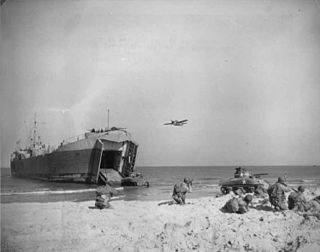
USS Lynx (AK-100) was a Crater-class cargo ship commissioned by the US Navy for service in World War II. Lynx was the third US Navy vessel to bear the name, but unlike previous ships this one was named after the constellation Lynx. She was responsible for delivering troops, goods and equipment to locations in the Asiatic-Pacific Theater.

USS Almaack (AKA-10) was an Almaack class attack cargo ship named after Almaack, a star system in the constellation Andromeda. She served as a commissioned ship for 4 years and 11 months.
USS Armstrong County (LST-57) was an LST-1-class tank landing ship built for the United States Navy during World War II. Named for counties in Pennsylvania, South Dakota, and Texas, she was the only U.S. Naval vessel to bear the name.

USS LST-209 was an LST-1-class tank landing ship built for the United States Navy during World War II. Like most of the ships of her class, she was not originally named, and known only by her designation. From June to August 1951 she served a stint as a part of the Military Sea Transportation Service (MSTS), manned by a civilian crew, and renamed USNS T-LST-209. She was recommissioned under her original name 24 August 1951, and renamed USS Bamberg County (LST-209) on 1 July 1955. She was named for Bamberg County, South Carolina, the only U.S. Naval vessel to bear the name.

USS Benzie County (LST-266) was an LST-1-class tank landing ship built for the United States Navy during World War II. Named for Benzie County, Michigan, she was the only U.S. Naval vessel to bear the name.

USS Berkeley County (LST-279) was an LST-1-class tank landing ship built for the United States Navy during World War II. Named for counties in South Carolina and West Virginia, she was the only U.S. Naval vessel to bear the name.

USS Berkshire County (LST-288) was an LST-1-class tank landing ship built for the United States Navy during World War II. Named for Berkshire County, Massachusetts, she was the only U.S. naval vessel to bear the name.

USS Bernalillo County (LST-306) was an LST-1-class tank landing ship built for the United States Navy during World War II. Named for Bernalillo County, New Mexico, she was the only U.S. Naval vessel to bear the name.

USS Blanco County (LST-344) was an LST-1-class tank landing ship built for the United States Navy during World War II. Named for Blanco County, Texas, she was the only U.S. Naval vessel to bear the name.

USS LST-356 was an LST-1-class tank landing ship built for the United States Navy during World War II. She earned three battle stars during the war and was decommissioned in July 1946. In July 1955, she was assigned the name USS Bledsoe County (LST-356) in honor of Bledsoe County, Tennessee, but never saw active service under that name. Bledsoe County was struck from the Naval Vessel Register in September 1960 and sold for scrapping in March 1961. She was apparently sold into commercial service in 1962 instead, serving under several names over the next five years. In 1967, she was acquired by the Indonesian Navy and renamed KRI Teluk Tomini (508). In 2012, the ship was decommissioned and scrapped.

USS Buncombe County (LST-510) was an LST-491-class tank landing ship built for the United States Navy during World War II. Named for Buncombe County, North Carolina, she was the only U.S. Naval vessel to bear the name. She currently serves as a ferry between New London, Connecticut, and Orient, Long Island.

USS Middlesex County (LST-983) was an LST-542-class tank landing ship built for the United States Navy during World War II. Named after counties in Connecticut, Massachusetts, New Jersey, and Virginia, she was the only United States Navy vessel to bear the name.

USS LST-19 was a United States Navy LST-1-class tank landing ship used exclusively in the Asiatic-Pacific Theater during World War II and manned by a United States Coast Guard crew. Like many of her class, she was not named and is properly referred to by her hull designation.

USS LST-16 was a LST-1-class tank landing ship built for the U.S. Navy during World War II. Like most ships in her class, she was not named and was known only by her designation. She was staffed by a U.S. Coast Guard crew throughout her service career.

USS Baretta (AN-41/YN-60) was an Ailanthus-class net laying ship which served with the U.S. Navy in the western Pacific Ocean theatre of operations during World War II. After surviving war action and Pacific Ocean typhoons, and she returned home safely after the war with one battle star to her credit.
USS LST-371 was a LST-1-class tank landing ship used by the United States Navy.

USS LST-21 was a United States Navy LST-1-class tank landing ship used primarily in the Europe–Africa–Middle East Theater during World War II, but also transported British forces from Calcutta and landed them at Regu Beach, Burma.

USS LST-22 was a United States Navy LST-1-class tank landing ship used exclusively in the Asiatic-Pacific Theater during World War II and staffed by a United States Coast Guard crew. Like many of her class, she was not named and is properly referred to by her hull designation.

USS LST-911 was an LST-542-class tank landing ship in the United States Navy. Like many of her class, she was not named and is properly referred to by her hull designation.

USS LST-779 was a United States Navy LST-542-class tank landing ship used in the Asiatic-Pacific Theater during World War II.


















